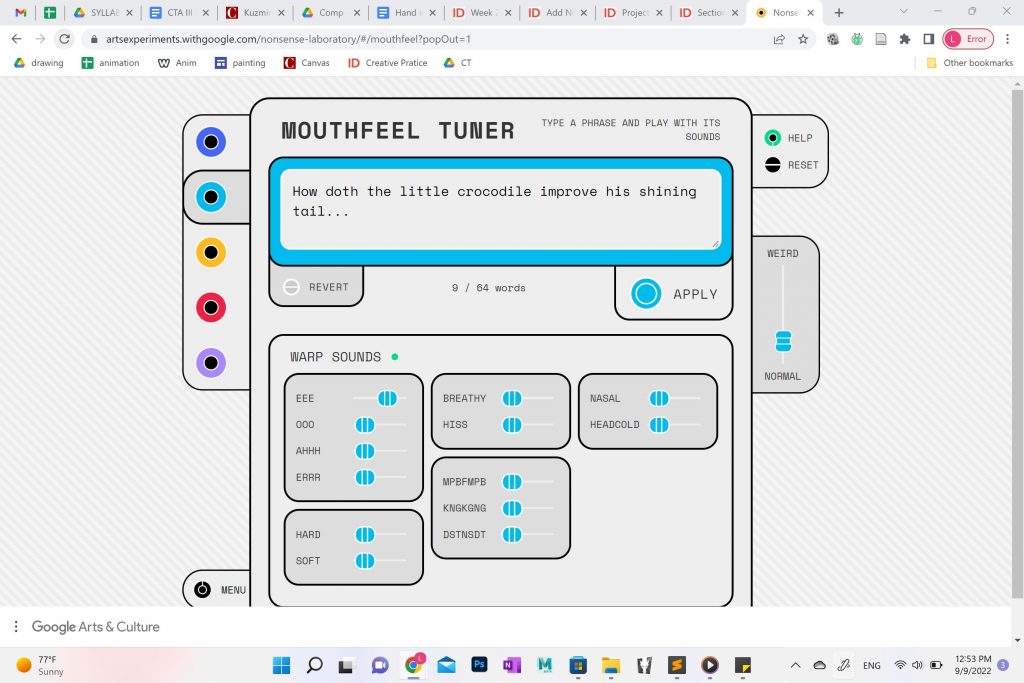This is my project 02 “Variable Faces”. The most challenging part of this project is organizing the logic of my code. Once the logic is sorted out it was actually not too complicated. I struggled a bit with certain shapes.
/* Jenny Wang
Section B */
var eyes = 3;
var features = 3;
var mouth = 3;
var hair = 3;
function setup() {
createCanvas(480, 640);
}
function draw() {
background(250,160,150);
noStroke()
fill(230,89,132);
ellipse()
noStroke();
fill(226,190,134);
ellipse(234,258,199,250);//face
strokeWeight(2); //nose
stroke(177,123,60);
line(231,272,220,300);
strokeWeight(2);
stroke(177,123,60);
line(220,300,236,302);
if(eyes<=1){ //round eyes
noStroke();
fill(255,255,255);
circle(182,252,46);
noStroke();
fill(162,196,231);
circle(182,252,29);
noStroke();
fill(43,91,137);
circle(182,252,17);
//left eye
noStroke();
fill(255,255,255);
circle(292,252,46);
noStroke();
fill(162,196,231);
circle(292,252,29);
noStroke();
fill(43,91,137);
circle(292,252,17);
//right eye
}
else if(eyes<=2){ //squint eyes
strokeWeight(3);
stroke(65,50,20)
line(170,253,197,265);
line(170,280,197,265);//left eye
line(270,265,297,254);
line(297,280,270,265);//right eye
}
else if (eyes<=3){ //half eyes
noStroke();
fill(255,255,255);
arc(182,252,46,46,2.6,0.5,open)
noStroke();
fill(164,209,125);
circle(182,252,29);
noStroke();
fill(177,123,57);
circle(182,252,17);
//left eye
noStroke();
fill(255,255,255);
arc(292,252,46,46,2.6,0.5,open)
noStroke();
fill(164,209,125);
circle(292,252,29);
noStroke();
fill(177,123,57);
circle(292,252,17);
}
if(features<=1){ //mole
strokeWeight(3);
fill(177,123,57)
point(186,321);
}
else if(features<=2){ //freckles
strokeWeight(3);
fill(177,123,57);
point(162,301);
strokeWeight(3);
fill(177,123,57);
point(177,309);
strokeWeight(3);
fill(177,123,57);
point(194,303);
strokeWeight(3);
fill(177,123,57);
point(265,306);
strokeWeight(3);
fill(177,123,57);
point(283,299);
strokeWeight(3);
fill(177,123,57);
point(298,308);
}
else if(features<=3){ //blush
noStroke();
fill(239,171,199);
ellipse(164,306,28,16);
noStroke();
fill(239,171,199);
ellipse(305,306,28,16);
}
if(mouth<=1){ //happy laugh
noStroke();
fill(246,166,193);
arc(237,324,80,70,0,0.6 + 2.6, OPEN);
}
else if(mouth<=2){//sad mouth
strokeWeight(4);
stroke(246,160,193);
line(214,350,235,343);
strokeWeight(4);
stroke(246,160,193);
line(256,350,235,343);
}
else if(mouth<=3){ //mouth with teeth
noStroke();
fill(237,10,124);
arc(237,324,80,70,0,0.6 + 2.6, OPEN);
noStroke();
fill(255,255,255);
rect(227,323,21,11);
}
if(hair<=1){ //red hair
noStroke();
fill(199,102,29);
arc(233,179,160,93,2.6,0.5, OPEN);
noStroke();
fill(199,102,29);
circle(347,197,95);
noStroke();
fill(199,102,29);
circle(116,197,95);
}
else if(hair<=2) { //blonde hair
noStroke();
fill(231,209,100);
circle(234,124,98);
noStroke();
fill(231,209,100);
circle(305,148,84);
noStroke();
fill(231,209,100);
circle(342,203,58);
noStroke();
fill(231,209,100);
circle(347,244,45);
noStroke();
fill(231,209,100);
circle(160,148,84);
noStroke();
fill(231,209,100);
circle(127,203,58);
noStroke();
fill(231,209,100);
circle(121,244,45);
}
else if(hair<=3){ //brown hair
noStroke();
fill(177,123,57);
arc(233,180,232,126,2.6,0.5, OPEN);
noStroke();
fill(177,123,57);
rect(118,180,38,205)
noStroke();
fill(177,123,57);
rect(311,180,38,205);
}
noStroke(); //neck
fill(226,190,134);
rect(210,378,48,63);
noStroke(); //body
fill(226,190,134);
rect(120,415,231,225,65,65,0,0);
noStroke(); //dress
fill(184,191,225);
quad(155,527,202,415,265,415,320,527);
noStroke();
fill(226,190,134);
triangle(202,415,265,415,233,475);
noStroke();
fill(184,191,225);
rect(155,527,164,113);
}
function mousePressed() {
eyes = random (0,3);
features = random (0,3);
mouth = random (0,3);
hair = random (0,3);
}
![[OLD SEMESTER] 15-104 • Introduction to Computing for Creative Practice](../../../../wp-content/uploads/2023/09/stop-banner.png)



